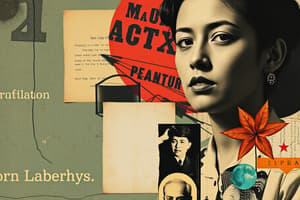Podcast
Questions and Answers
What does the color Umber symbolize in Noli Me Tangere and El Filibusterismo?
What does the color Umber symbolize in Noli Me Tangere and El Filibusterismo?
What is the purpose of satire in Noli Me Tangere and El Filibusterismo?
What is the purpose of satire in Noli Me Tangere and El Filibusterismo?
What do the symbolic character names add to the narrative of Noli Me Tangere and El Filibusterismo?
What do the symbolic character names add to the narrative of Noli Me Tangere and El Filibusterismo?
What does the River symbolize in Noli Me Tangere and El Filibusterismo?
What does the River symbolize in Noli Me Tangere and El Filibusterismo?
Signup and view all the answers
What is the purpose of imagery in Noli Me Tangere and El Filibusterismo?
What is the purpose of imagery in Noli Me Tangere and El Filibusterismo?
Signup and view all the answers
What does the Leper symbolize in Noli Me Tangere and El Filibusterismo?
What does the Leper symbolize in Noli Me Tangere and El Filibusterismo?
Signup and view all the answers
Study Notes
Symbolism in Noli Me Tangere and El Filibusterismo
- The Color Umber: Symbolizes the gloomy and oppressive atmosphere of the Philippines during the Spanish colonial period.
- The Leper: Represents the social outcasts and the marginalized, highlighting the injustices and cruelties of the colonial regime.
- The Forest: Symbolizes the unknown, the mysterious, and the uncharted territories of the Filipino psyche.
- The River: Represents the flow of life, the passage of time, and the connection between the past and the present.
Literary Devices in Noli Me Tangere and El Filibusterismo
- Irony: Used to highlight the contradictions and hypocrisies of the colonial regime, as well as the characters' own flaws and shortcomings.
- Satire: Employed to critique the social ills and corruption of the time, particularly the abuse of power and the exploitation of the native population.
- Imagery: Used to create vivid and powerful descriptions of the Philippines and its people, evoking emotions and sensations in the reader.
- Symbolic Character Names: Many characters have names that reflect their personalities, occupations, or roles in the story, adding depth and meaning to the narrative.
- Allusions: References to historical events, myths, and legends add layers of meaning and context to the narrative, enriching the reader's understanding of the story.
Symbolism in Noli Me Tangere and El Filibusterismo
- The color umber represents the gloomy and oppressive atmosphere of the Philippines during the Spanish colonial period, symbolizing the country's struggles under colonial rule.
- The leper character serves as a symbol of social outcasts and marginalized groups, highlighting the injustices and cruelties of the colonial regime and its impact on the native population.
- The forest is a symbol of the unknown, the mysterious, and the uncharted territories of the Filipino psyche, evoking feelings of uncertainty and exploration.
- The river symbolizes the flow of life, the passage of time, and the connection between the past and the present, emphasizing the importance of understanding the country's history.
Literary Devices in Noli Me Tangere and El Filibusterismo
- Irony is used to expose the contradictions and hypocrisies of the colonial regime, as well as the characters' own flaws and shortcomings, creating a sense of critique and social commentary.
- Satire is employed to critique the social ills and corruption of the time, particularly the abuse of power and the exploitation of the native population, highlighting the need for social change.
- Imagery is used to create vivid and powerful descriptions of the Philippines and its people, evoking emotions and sensations in the reader and immersing them in the story.
- Symbolic character names are used to add depth and meaning to the narrative, reflecting the characters' personalities, occupations, or roles in the story.
- Allusions to historical events, myths, and legends add layers of meaning and context to the narrative, enriching the reader's understanding of the story and its significance.
Studying That Suits You
Use AI to generate personalized quizzes and flashcards to suit your learning preferences.
Description
Explore the symbolic significance of various elements in Jose Rizal's novels, including colors, characters, and natural settings. Uncover the deeper meanings behind these symbols in the context of the Philippine colonial period.




